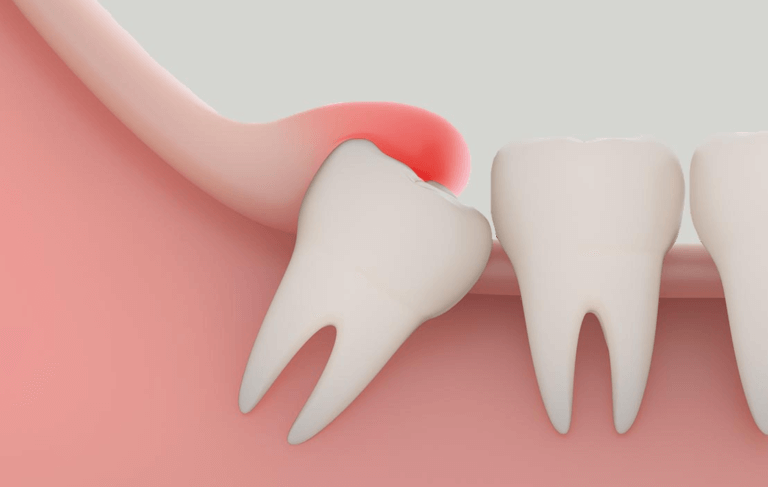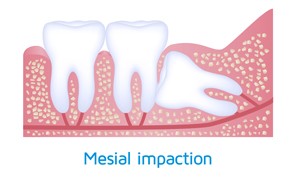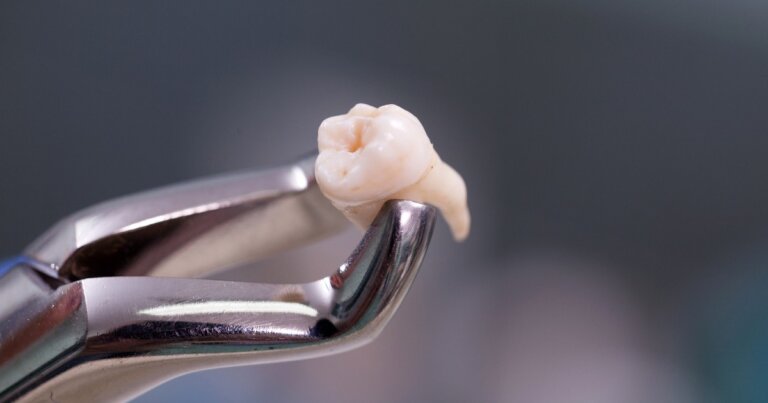Pericoronitis

What Is Pericoronitis?
Pericoronitis is a painful dental condition that occurs when the gums around a partially erupted wisdom tooth becomes inflamed and infected. Wisdom teeth, also known as third molars, typically emerge between the ages of 17 and 25, but because of the shrinking size of the human jaw over time, they may not grow fully upright. When this happens, food particles and bacteria can become trapped beneath the gum flap, leading to infection and inflammation.
Pericoronitis can cause a range of symptoms, including pain, gum swelling, redness, and difficulty opening the mouth. In some cases, it can also lead to fever and swollen lymph nodes. If left untreated, pericoronitis can progress and potentially lead to more serious complications, such as abscess formation or even systemic infection. Before you contact a Toronto dentist to examine Pericoronitis, there are some things you should know as a patient:
- Why Do I Have Pericoronitis?
- Signs And Symptoms Of Pericoronitis
- Treatment Options For Pericoronitis
- How To Prevent Pericoronitis
- Managing Pericoronitis Until You Can See The Dentist
If you have questions about Pericoronitis or other dental problems, please contact us for more information.
Why Do I Have Pericoronitis?
Pericoronitis is usually caused by a variety of factors, which include:
- Partially erupted wisdom tooth: When a wisdom tooth only partially emerges from the gum tissue, it can create a flap of gum that can trap food particles and bacteria, leading to infection and inflammation.
- Poor oral hygiene: An inability to properly brush and floss around the impacted wisdom teeth can allow bacteria to accumulate in the mouth, increasing your risk of pericoronitis.
- Compromised immune system: If you have a weakened immune system due to illness, medication, or other factors, you may be more susceptible to developing pericoronitis.
If you have any of these risk factors, it’s important to be extra vigilant about your oral hygiene and to seek prompt dental care if you experience any symptoms of pericoronitis. If you have further questions about Pericoronitis, please contact us.

Signs And Symptoms Of Pericoronitis
Pericoronitis can cause a variety of symptoms, which can range from mild to severe. Here are some of the most common signs and symptoms of pericoronitis:
- Pain or discomfort: Pain is one of the most common symptoms of pericoronitis. It may be localized to the back part of your mouth where your wisdom teeth are, or radiate to other parts of the jaw or face.
- Gum swelling: Swelling and inflammation of the gum tissue surrounding the affected tooth are also common symptoms of pericoronitis. In some cases, the swelling may be severe enough to be seen extra-orally, and even make it difficult to fully open the mouth.
- Redness: The gum tissue around the affected tooth may appear red or irritated.
- Bleeding: The area around the impacted wisdom tooth may bleed easily with any kind of irritation.
- Difficulty chewing: If the affected tooth is in the back of the mouth, you may experience difficulty chewing or biting down.
- Difficulty opening the jaw: When the pericoronitis becomes severe, it can cause swelling that can make opening and closing your jaw difficult.
- Bad taste or bad breath: The accumulation of food particles, pus discharge, and bacteria can lead to a bad taste or odor in the mouth.
- Fever and swollen lymph nodes: In more severe cases, pericoronitis can cause fever and swollen lymph nodes in the area of the head and neck.
If you are experiencing any of these symptoms, it’s important to seek dental care as soon as possible. Left untreated, pericoronitis can progress and potentially lead to more serious complications, such as abscess formation or systemic infection. If you have further questions about the signs and symptoms of Pericoronitis, please contact us.
Treatment Options For Pericoronitis
The best thing to do if you think you have wisdom tooth pain, swelling and infection is to seek the help of a dentist. The dentist will first take an x-ray image to visualize the wisdom tooth problem and arrive at a proper diagnosis before recommending treatment. Pericoronitis can usually be treated effectively with a combination of professional dental treatments, which can include:
- Antibiotics: Dentists do not always like to prescribe antibiotics because it can have bad systemic effects on the body. But if it is determined that antibiotic medicine is needed, the dentist will write a prescription that can be taken to your pharmacy. Common antibiotics include Amoxicillin and Clindamycin.
- Wisdom tooth removal: If the infection is severe or recurrent, your dentist may recommend surgery to remove the gum flap or extract the affected tooth. The procedure is typically performed under local anesthesia and may involve surgical incisions in the gum to reveal more of the wisdom tooth, troughing of bone around the wisdom tooth, and cutting the wisdom tooth in pieces in order to effectively remove it. The area is then sutured closed to aid in healing.
- Teeth cleaning: A deep and thorough scaling and root planing can be effective in removing plaque and calculus that irritates the gums around wisdom teeth. Teeth cleaning is typically performed by a dental hygienist or dentist using special manual and ultrasonic tools to scrape and polish the teeth.
- Operculectomy: This is the surgical procedure of removing the operculum, or the flap of gum that partially covers a tooth. The procedure is typically performed under local anesthesia and involves making a small incision in the gum tissue to remove the operculum. The area is then sutured closed to aid in healing.
If you have pericoronitis, it’s important to follow your dentist’s recommended treatment plan and practice good oral hygiene to prevent future infections. If you have further questions about treatment options for Pericoronitis, please contact us.

How To Prevent Pericoronitis
While pericoronitis can be treated, it’s always better to prevent it from happening in the first place. Here are some tips to help you prevent pericoronitis:
- Practice good oral hygiene: Brush your teeth at least twice a day and floss at least once a day to remove food particles and bacteria that can contribute to infection and inflammation. The Waterpik waterflosser is also a terrific adjunctive tool to keep the area around your wisdom teeth clean.
- Visit your dentist regularly: Regular dental checkups and teeth cleanings can help your dentist identify and treat any potential wisdom teeth issues before they develop into more serious problems.
- Monitor your wisdom teeth: If you have wisdom teeth, be sure to monitor them for signs of partial eruption or impaction. If you notice any signs of trouble, such as pain or swelling, contact your dentist right away.
- Consider wisdom tooth extraction: If your wisdom teeth are causing problems or are likely to cause problems in the future, your dentist may recommend extracting them to prevent complications such as pericoronitis.
By following these tips, you can help reduce your risk of developing pericoronitis and other oral health issues. If you have further questions about how to prevent Pericoronitis, please contact us.
Managing Pericoronitis Until You Can See The Dentist
If you are experiencing symptoms of pericoronitis and are unable to see a dentist right away, there are some things you can do to manage the symptoms and help prevent the infection from getting worse. Here are some tips:
- Use Over-the-Counter Pain Medication: Over-the-counter pain medication, such as Advil (ibuprofen) or Tylenol (acetaminophen), can help relieve tooth pain from pericoronitis. Follow the instructions on the label and do not exceed the recommended dose. Unless you have a health condition that prevents you from taking either ibuprofen or acetaminophen, the absolute maximum dose that I recommend patients take for the worst dental pain is 600 mg ibuprofen combined with 1000 mg acetaminophen every 4 to 6 hours.
- Practice good oral hygiene: Keeping the area around the wisdom tooth as clean as possible can help prevent further damage and alleviate some of the pain or sensitivity. Brush and floss gently around the tooth. Rinsing your mouth with warm salt water or mouthwash can help reduce infection, inflammation and alleviate toothache pain. You can buy any mouthwash available at your pharmacy or health foods store. Alternatively, you can mix a teaspoon of salt in a cup of warm water and swish the solution around your mouth for about 30 seconds before spitting it out. If you do not already have a Waterpik waterflosser, it is also a terrific adjunctive tool to keep the area around your wisdom teeth clean.
- Apply a cold compress: This can help reduce swelling and numb the area.
- Avoid eating on the affected side: If eating food on the side of the mouth that has pericoronitis causes pain, it is best to avoid eating on it and favor using the other side of your mouth. Stick to soft foods such as yoghurt, oatmeal or congee.
While these measures can help manage your symptoms, it’s still important to seek professional dental care as soon as possible. Left untreated, pericoronitis can progress and potentially lead to more serious complications. If you have further questions about how to manage Pericoronitis, please contact us.

